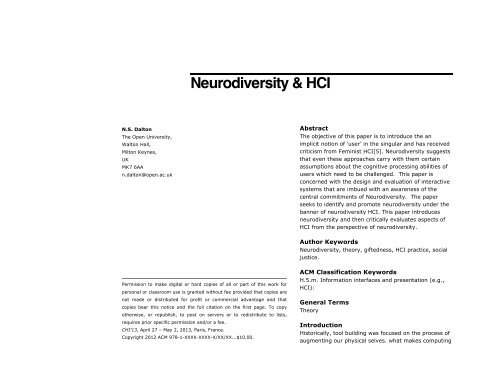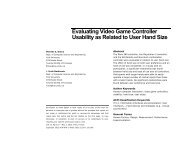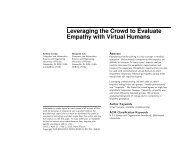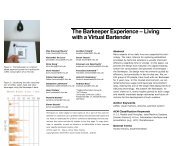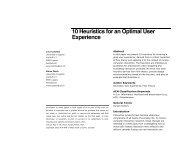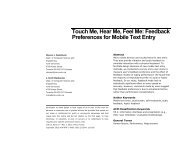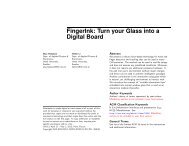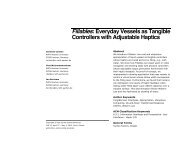Neurodiversity & HCI - alt.chi 2013
Neurodiversity & HCI - alt.chi 2013
Neurodiversity & HCI - alt.chi 2013
You also want an ePaper? Increase the reach of your titles
YUMPU automatically turns print PDFs into web optimized ePapers that Google loves.
N.S. D<strong>alt</strong>on<br />
The Open University,<br />
W<strong>alt</strong>on Hall,<br />
Milton Keynes,<br />
UK<br />
MK7 6AA<br />
n.d<strong>alt</strong>on@open.ac.uk<br />
<strong>Neurodiversity</strong> & <strong>HCI</strong><br />
Permission to make digital or hard copies of all or part of this work for<br />
personal or classroom use is granted without fee provided that copies are<br />
not made or distributed for profit or commercial advantage and that<br />
copies bear this notice and the full citation on the first page. To copy<br />
otherwise, or republish, to post on servers or to redistribute to lists,<br />
requires prior specific permission and/or a fee.<br />
CHI’13, April 27 – May 2, <strong>2013</strong>, Paris, France.<br />
Copyright 2012 ACM 978-1-XXXX-XXXX-X/XX/XX...$10.00.<br />
Abstract<br />
The objective of this paper is to introduce the an<br />
implicit notion of ‘user’ in the singular and has received<br />
criticism from Feminist <strong>HCI</strong>[5]. <strong>Neurodiversity</strong> suggests<br />
that even these approaches carry with them certain<br />
assumptions about the cognitive processing abilities of<br />
users which need to be challenged. This paper is<br />
concerned with the design and evaluation of interactive<br />
systems that are imbued with an awareness of the<br />
central commitments of <strong>Neurodiversity</strong>. The paper<br />
seeks to identify and promote neurodiversity under the<br />
banner of neurodiversity <strong>HCI</strong>. This paper introduces<br />
neurodiversity and then critically evaluates aspects of<br />
<strong>HCI</strong> from the perspective of neurodiversity.<br />
Author Keywords<br />
<strong>Neurodiversity</strong>, theory, giftedness, <strong>HCI</strong> practice, social<br />
justice.<br />
ACM Classification Keywords<br />
H.5.m. Information interfaces and presentation (e.g.,<br />
<strong>HCI</strong>):<br />
General Terms<br />
Theory<br />
Introduction<br />
Historically, tool building was focused on the process of<br />
augmenting our physical selves. what makes computing
different is that these tools support the process of<br />
thought. Human Computer Interaction (<strong>HCI</strong>) is a<br />
subject concerned with the process of making tools<br />
which support the process of thinking, and it is this that<br />
in some way makes <strong>HCI</strong> unique compared to other tool<br />
making areas.<br />
From its earliest inception, <strong>HCI</strong> has had the notion of<br />
‘the user’ from ‘user centered design’ to ‘user<br />
participation’ there is the implicit notion of ‘user’ in the<br />
singular. This notion of ‘user’ in the singular has come<br />
under criticism from Feminist <strong>HCI</strong>[5]. <strong>Neurodiversity</strong><br />
suggests that even these approaches carry with them<br />
certain assumptions about the cognitive processing<br />
abilities of users which need to be challenged. This<br />
paper is concerned with the design and evaluation of<br />
interactive systems that are imbued with an awareness<br />
of the central commitments of neurodiversity. The<br />
paper seeks to identify and promote neurodiversity to<br />
<strong>HCI</strong> under the banner of neurodiversity <strong>HCI</strong>. This paper<br />
will begin by introducing neurodiversity, then move on<br />
to critically evaluate aspects of <strong>HCI</strong> from the<br />
perspective of <strong>Neurodiversity</strong>.<br />
<strong>Neurodiversity</strong><br />
The term neurodiversity was coined by Judy Singer a<br />
sociologist with Asperger syndrome and autistic rights<br />
advocate writing as part of a self advocacy<br />
movement[28]. The term has since spread to a number<br />
of support groups, blogs and books. It could be argued<br />
that this self advocacy rights movement formed partly<br />
due to the ability of members of the autistic community<br />
to come together on line and communicate with-out<br />
intermediaries as was the case with many of the<br />
previous organizations formed by parents and<br />
professionals. Singer’s notion of neurodiversity was that<br />
autism and Asperger’s were not an ‘affliction’ but<br />
another state of being[20] with equal rights to live and<br />
reproduce. The neurodiversity community uses the<br />
term ‘neurotypical’ to label the larger ‘normal’ society.<br />
Over time the neurodiversity community has grown to<br />
include conditions such as Dyslexia, Dyscalulia,<br />
Dyspraxia/DCD, Autistic Spectrum Disorder, Asperger’s<br />
Syndrome, Tourette’s Syndrome and Attention Deficit<br />
Hyperactivity Disorder (ADHD). This list should not be<br />
seen as definitive as many other conditions may be<br />
included. While other conditions many included there<br />
are for those such as Armstrong [2] three aspects<br />
which help define <strong>Neurodiversity</strong>: upsides, the social<br />
model of disability, and the spectrum of disorder.<br />
1. Upsides<br />
Neuroscientist Professor John Stein observes from an<br />
evolutionary point of view, “If conditions like dyslexia<br />
are wholly negative they would have evolved out” [15].<br />
For neurodiversity, it is the positive aspects of the<br />
conditions that differentiate them from traditional<br />
‘disabilities’. People with autism and Asperger’s are<br />
likely to do well at the embedded figures task, possess<br />
above average attention to detail, have strong visualspatial<br />
skills, and are more likely to have perfect<br />
musical pitch. Those with Williams Syndrome are likely<br />
to be talented musically and have good interpersonal<br />
skills. Dyslexics tend to be highly creative and strong<br />
visual thinkers with the ability to develop a good<br />
overview of large complex problems. Those with<br />
attention deficit hyper activity disorder (ADHD) are<br />
likely to be highly creative and strong multi-taskers<br />
with the ability to operate in stressful high-input<br />
situations. Given the right triggers they are able to<br />
hyper-focus on tasks[2]. This list is highly incomplete.<br />
Generally, we only know about positive aspects if they
can be construed as negative, or if they have come<br />
about serendipitously from other research. One of the<br />
problems is that the medical community has the<br />
motivation and resources to explore these conditions<br />
but tends to ‘medicalize’ conditions [9][10] by focusing<br />
on the negative aspects. While this research has been<br />
highly useful in identifying differences in brain structure<br />
rather than ‘laziness’ or ‘poor parenting’ as causes, it<br />
does lead to the temptation to begin to cure these<br />
‘afflictions’.<br />
It is natural then that computing & <strong>HCI</strong> have already<br />
followed previous modes of research by viewing these<br />
conditions under the larger banner of ‘disability’. A<br />
meta-review was carried out for this paper by studying<br />
papers from both the ACM library including CHI and<br />
SIGACCESS proceedings for the years 1999- 2012<br />
show that of 55 references to conditions of dyslexia or<br />
autism, no paper made any positive mention of any<br />
aspect of either of these conditions.<br />
For many of the neurodiverse community it is these<br />
positive aspects which can be highly useful and<br />
principle components of their value and so identity. As<br />
Cooper says “I am not someone with dyslexia. I am<br />
dyslexic. Were I not dyslexic, I would not be me”[9]. It<br />
is the co-identification with the condition that produces<br />
what a neurotypical might think of as possibly perverse<br />
behaviors. For example medication exists to reduce the<br />
effects of ADHD. Yet this medication typically also<br />
reduces the positive aspects such as creativity as well.<br />
If a neurodiverse person in a creative job and<br />
considerably more creative than their neurotypical<br />
coworkers, it would be natural to expect them to be<br />
less than enthusiastic about taking a drug which might<br />
eliminate their unique advantage regardless of the<br />
negative aspects.<br />
2. Social Model of Disability<br />
So far we have seen that there has been an<br />
unintentional bias to medically label many of these<br />
cognitive conditions as illness. If there are upsides, this<br />
raises the question: are the neurodiverse truly<br />
disabled? One primary aspect of the ‘difference’ to<br />
‘affliction’ debate is that of the social model of disability<br />
[16]. We live in a modern complex interconnected<br />
world far different from the environment in which<br />
humanity evolved. As society becomes more complex,<br />
we are required to meet many social norms in order to<br />
access society’s basic resources.<br />
As an example, consider conditions such as ADHD. In<br />
primitive hunter gatherer societies a hunter with the<br />
ability to multi-task between hunting, navigating,<br />
gathering all while avoiding numerous threats. With<br />
survival depending upon the ability to swit<strong>chi</strong>ng rapidly<br />
between stimuli suggests that those with ADHD would<br />
function well in a pre-civilized hunter gatherer society.<br />
Today the in-ability to work attentively in a class room<br />
or receptively on a production line makes those with<br />
ADHD poorly suited to earn income and so function in<br />
the modern world.<br />
Alternatively, imagine a community consisting of purely<br />
Asperger’s individuals the inability to use non verbal<br />
communication skills and limited empathy with their<br />
peers would no longer make them unable to function,<br />
they would be normal. It is being the lone Asperger’s<br />
individual in the neurotypical world and not being able<br />
to meet general social norms that creates disability.
Gifted neurodiverse<br />
individuals<br />
Einstein: Dyslexia,Autism.<br />
Paul Dirac: Autism<br />
Mozart: ADHD<br />
Shakespeare: ADHD<br />
Tracey Emin: Dyslexia<br />
Ludwig van<br />
Beethoven:Autism<br />
Michael Faraday: Dyslexia<br />
Dr. Samuel Johnson:<br />
Tourettes<br />
For example, a dyslexic in a pre-literate society would<br />
have little difficulty functioning and find the positive<br />
aspects of the condition useful. It is the switch to near<br />
universal literacy and society’s dependence on high<br />
literacy which then denies a dyslexic access to the<br />
resources that creates dependence on external<br />
assistance which is the mark of disability. There is little<br />
doubt discrimination and disability exist. Examples of<br />
such discrimination for dyslexics are: education<br />
commensurate with IQ is refused [8] , employment<br />
opportunities may be restricted [6], in the US, their<br />
unemployment is twice as high compared to those<br />
without learning disabilities[11] wages may be less<br />
than their able and equally qualified counter<br />
parts[17][18], ability to rise to higher levels of<br />
management curtailed [21], some fear downgrading,<br />
career termination or dismissal if their difference is<br />
revealed [22]. It is for this and other reasons that<br />
Dyslexia is defined as a disability and employment<br />
protection legislation exists under the Americans with<br />
Disabilities Act[19] and the UK disability discrimination<br />
Act.<br />
From these examples it should be clear that disability is<br />
more about the inability to function in a neurotypical<br />
society to a greater extent than being able to function<br />
in some absolute sense. As Finkelstein says “The<br />
central issue in our campaign is for a better life,<br />
therefore, we ought to be concerned with issues around<br />
emancipation and this requires struggles for social<br />
change rather than concentrating on individual<br />
experiences, ‘rehabilitation’, etc” [16].<br />
It is this struggle with emancipation and social change<br />
that the neurodiversty movement seeks to foster. From<br />
an <strong>HCI</strong> perspective, optimizing the interaction with<br />
software with only one cognitive model is slowly<br />
eroding it’s use by those with differing cognitive<br />
strengths and weaknesses. As designers and builders<br />
of tools with a particular cognitive perspective, we are<br />
potentially engaging in the further disenfran<strong>chi</strong>sement<br />
of a number of groups and so creating more disability.<br />
3. Spectrum of Disorder<br />
The final aspect which makes neurodiversity stand out<br />
and makes its highly relevant for <strong>HCI</strong> is the spectrum<br />
observations from D<strong>alt</strong>on’s[13] observations that most<br />
neurodiversity conditions are spectrum disorders<br />
ranging from normal to dysfunctional. One of the<br />
problems with conditions like dyslexia and Asperger’s<br />
syndrome is that it is hard to give a definite diagnosis<br />
about who is or isn’t afflicted with the condition. Figures<br />
on the prevalence of dyslexia for example range from<br />
1-15% of the population due to the operational<br />
definition of how severe the condition is expected to be<br />
in order to be categorized as dyslexia. We must also<br />
consider that the negative and positive sides of a<br />
condition can impact an individual at different rates.<br />
This becomes clear when we consider the work of<br />
Baum[7], looking at the education of gifted and<br />
learning disabled individuals, Baum observes that the<br />
range of those with intellectual differences may be<br />
larger than those simply labeled ‘learning disabled’.<br />
Baum suggests there are three categories of<br />
‘giftedness’:<br />
• Identified gifted students who have subtle<br />
learning disabilities- these are students who<br />
fall only slightly short of the vision of genius.<br />
They have some shortcomings but their gifts<br />
greatly outweigh any negatives, the overall<br />
result is still worthy of the label ‘gifted’.
• Identified learning-disabled students who are<br />
also gifted- when the burden of learning<br />
disabilities outweighs the gifts, these<br />
individuals fall into the category of learning<br />
disabled students.<br />
• Unidentified students- these are students who<br />
have a heavier burden of learning disabilities<br />
but also gifts, by using their talents to<br />
overcome their weaknesses they result in<br />
appearing only ‘average’ to their<br />
contemporaries. Their gifted qualities may go<br />
unnoticed. This adaptation mechanism can be<br />
so effective that individuals may not<br />
themselves be aware of having a condition and<br />
may only be identified much later in life. For<br />
example, some successful adults with ADHD<br />
are only identified when their <strong>chi</strong>ldren are<br />
diagnosed.<br />
As such, we can see some aspects of high functioning<br />
abilities in relation to what is typically seen as<br />
disability. This situation can be more clearly explained<br />
in figure 1. Here we consider two axes. The first vertical<br />
axis is that of degree of ability. While degree of<br />
cognitive function is both subjective and, as we argued,<br />
also bound by socially enforced norms, the axis relates<br />
to our everyday notion of cognitive ability. The<br />
horizontal axis is the severity of condition. Again, this<br />
synthetically combines both positive and negative<br />
aspects of a particular condition. For example, we<br />
might begin on the left with Asperger’s and the move to<br />
autism on the right. The curve consists of a number of<br />
individuals conceptually plotted along the scattergram.<br />
It begins in the middle with what would be regarded as<br />
neurotypical. As the cognitive condition (dyslexia,<br />
Asperger’s, ADHD) increases minor problems occur but<br />
are outweighed by the benefits. At the peek this zone<br />
comprises people that Baum identifies as ‘Identified<br />
gifted students who have subtle learning disabilities’. As<br />
the curve reaches its zenith, we enter the talented<br />
zone, and we see the people we would regard as truly<br />
gifted. Einstein is held up as an icon for dyslexics, but<br />
he was never tested during his life. As problems<br />
increase, we enter the zone where the negatives<br />
outweigh the positives. It in this zone close to the<br />
‘normal’ line we find Baum’s ‘Unidentified students’.<br />
These are people who appear normal but have to<br />
devote a huge amount of their gifts to cope or manage<br />
the downsides. As mentioned many people who are so<br />
adept at coping and in doing so appear as<br />
unexceptional can discover a cognitive problem later in<br />
life are likely to appear in this area. Finally, when the<br />
negatives outweigh the positives, we get the severe<br />
end of any condition. Occasionally we see gifts as seen<br />
in savants for instance, the ability to multiply 20 digit<br />
numbers yet are unable to tie a shoelace.<br />
So, we have seen that neurodiversity consists of three<br />
pillars. Upsides and the spectrum help to explain that<br />
these conditions are not one-off defects or aberrations<br />
but a reflection of the larger diversity of humanity.<br />
Case studies of the <strong>Neurodiversity</strong><br />
Perspective for <strong>HCI</strong><br />
The paper will now use the view of neurodiversity to<br />
reflect upon a number of case studies which will<br />
demonstrate how the neurodiversity perspective is<br />
relevant to <strong>HCI</strong>.
Figure 1: A conceptual curve of ‘ability’ against ‘degree’ of<br />
condition.<br />
Users and spectrum<br />
From an <strong>HCI</strong> perspective, resear<strong>chi</strong>ng and responding<br />
to neurodiversity should be seen not as an extension of<br />
e-inclusion [1] and disability but more as a<br />
fundamental and subtle response to the wider diverse<br />
user community. If the neurodiverse are part of a<br />
spectrum, then being inclusive to other cognitive<br />
modes suggests wider benefits. For example, Alan Dix<br />
[14] observes that supporting assistive materials and<br />
technologies for neurodiverse students has an effect of<br />
making the material more accessible for the wider<br />
student population. It seems natural to suggest that it<br />
would be reasonable to expect that technologies that<br />
support assorted gifts from the neurodiverse<br />
community might have an audience much larger than<br />
the neurotypical. If we can support the gifted in the<br />
more specialist neurodiverse community, then it is<br />
natural that we might expect wider benefits.<br />
Giftedness<br />
Baum’s [7] work implies that we can consider the<br />
neurodiverse in relation to high functioning intellectual<br />
activity, and this is an area which has received little<br />
attention in the <strong>HCI</strong> literature. We need to see<br />
neurodiversity not only as approa<strong>chi</strong>ng issues of the<br />
negative sides of the conditions but as a new<br />
opportunity to study the positive gifted and talented<br />
aspects of conditions traditionally viewed as disabilities.<br />
There have been many calls to explore <strong>HCI</strong> 2.0 aspects<br />
such as creativity, sociability, joy, and user<br />
temperament[26]. What makes these aspects intriguing<br />
in terms of neurodiversity <strong>HCI</strong> [12] is that they are<br />
areas were the neurodiverse are typically very strong.<br />
As[2] suggests, it is in supporting the positive aspects<br />
of neurodiversity that members of the neurodiverse<br />
community can find value in themselves. One example<br />
of this is Aspiritech[23] which uses Asperger’s/autistic<br />
spectrum engineers to perform very high value testing<br />
of software. By doing so they are able to find more<br />
software defects than similar neurotypcially staffed<br />
companies. <strong>HCI</strong> is then challenged to facilitate new<br />
kinds of interfaces to support new kinds of value<br />
creation.<br />
<strong>Neurodiversity</strong> within computing and <strong>HCI</strong><br />
It is obvious but regrettable that <strong>HCI</strong> does not reflect<br />
the wider user community, in terms of gender, culture,<br />
ethnicity and other aspects. Yet for <strong>HCI</strong>, awareness of<br />
neurodiversity does highlight a number of aspects<br />
within our own community. This part of the paper will<br />
highlight this aspect as it may have an impact in terms<br />
of how the <strong>HCI</strong> community reflects upon itself and its<br />
evolution.<br />
In the book Microserfs author Douglas Coupland<br />
observes, "I think all tech people are slightly autistic.".
So long as you don’t type outside<br />
the right margin, it’s okay to put<br />
annotations over here on the right,<br />
too. Remember to use the<br />
annotation text style.<br />
Steve Silberman[27] reports on the high levels of<br />
autism and Asperger’s syndrome in Silicon Valley<br />
suggesting a link between that and the high tech<br />
computing industry there. Silberman even identifies<br />
some of the qualities of famous IT professionals such as<br />
Bill Gates as being parallel to such conditions.<br />
Attwood[3] [4] also reported high numbers of people<br />
with Asperger’s amongst IT professionals.<br />
In terms of computation and interaction there are a<br />
higher proportion of dyslexics in the software<br />
community. [29] Reports Approximately 30% of<br />
dyslexic undergraduates study scientific, engineering or<br />
medical disciplines. Pure programming is a good<br />
example of an intellectual activity which currently fails<br />
to discriminate against dyslexics. Powell suggests that<br />
the positive aspects of dyslexia (good overview, visual<br />
thinking, creativity) can be of help. ‘Programming is an<br />
arena where dyslexics can really flourish’[25].<br />
In [24] O’Keefe suggests that dyslexia was called the<br />
‘MIT disease’ because both Nicolas Negroponte and<br />
many of the researchers at the Media Lab were<br />
themselves dyslexic. Many dyslexics move into<br />
intellectual domains that can take advantage of high<br />
visual ability and strong creative passion which is<br />
typical of the visual arts. [30] Reports that 5.59% of<br />
UK Creative Arts and Design where dyslexic compared<br />
to 1.9% for all UK undergraduates and 4-10% for the<br />
general population. One study reported by<br />
Armstrong[2] identified 75% of fine art students at one<br />
of the top art schools in the UK as being dyslexic. This<br />
suggests that those in the area of interaction design<br />
may have a higher tendency for dyslexia.<br />
If this rate is reflected in interaction design, it is more<br />
surprising that neurodiversity has not emerged as an<br />
issue already. From this we might conclude while<br />
neurodiversity is an invisible disability, it also forms ‘an<br />
invisible community’ or at least a self-unaware<br />
community with in the <strong>HCI</strong> community. This part of the<br />
vision of neurodiversity <strong>HCI</strong> is to recognize and<br />
research the effects that <strong>Neurodiversity</strong> has potentially<br />
had already. Does creating a neurodiversity framework<br />
create a new kind of ontology about <strong>HCI</strong> and change<br />
the way we reflect upon our selves and our methods of<br />
practice? We believe that using neurodiversity as a<br />
banner under which this kind of work can be articulated<br />
will provide fresh insights into the practice of <strong>HCI</strong>.<br />
Challenges for <strong>HCI</strong> research practice<br />
As digital technologies become a greater part of our<br />
every day lives, they become vital aspects of our ability<br />
to both exploit society’s resources to live and<br />
importantly deliver value and employment in the larger<br />
economy. So on the one hand, interaction technology<br />
has the potential to further disenfran<strong>chi</strong>se and further<br />
marginalize the neurodiverse. On the other hand, we<br />
have seen that there are a large number of untapped<br />
gifts which the neurodiverse possess. By creating<br />
technologies to help exploit these gifts <strong>HCI</strong> has the<br />
opportunity to develop new we<strong>alt</strong>h creating potential in<br />
the neurodiverse and for the betterment of all.<br />
Further, if research is undertaken which can exploit<br />
aspects of giftedness in the neurodiverse, we can see<br />
from the spectrum argument that there are many in<br />
the neurotypical community that may be able to find<br />
advantage from this research. <strong>HCI</strong> research is a<br />
discipline which is strongly tied to and highly influential<br />
on the development of new interaction technologies.<br />
Therefore, it is natural for the neurodiverse to be able<br />
to raise its voice in this community. It is this voice<br />
which neurodiversity <strong>HCI</strong> tries to articulate. As
mentioned above, it seems natural that there are many<br />
within the neurodiverse community in the field of<br />
computing and interaction design already and it seems<br />
natural to begin to expect them to speak up.<br />
To understand why this has not yet happened we must<br />
begin to ask about the barriers that the academic study<br />
of <strong>HCI</strong> research introduces. By its very nature human<br />
computer interaction is hardly attractive to those with<br />
poor social skills. Yet the academic setting also<br />
demands high literacy skills as a barrier to entry to the<br />
high table of influencing the larger research agenda.<br />
These and other aspects all cumulate to exclude many<br />
from the neurodiverse community as active participants<br />
in top level research.<br />
<strong>Neurodiversity</strong> at its heart has the agenda that differing<br />
cognitive styles are respected as different rather than<br />
seen as ‘able’ and ‘defective’. As such, the broader<br />
social aims of neurodiversity can be seen as a fight to<br />
raise awareness of differing cognitive styles. For<br />
example only 5% of people with Tourette’s swear, but<br />
they are much more likely to be musically gifted. It also<br />
seeks changes in the wider society to discourage<br />
focusing on individual problems toward a wider social<br />
emancipation. In the field of academic <strong>HCI</strong> we must<br />
start the conversation as to what aspects of our own<br />
procedures, customs, and protocols inhibit those in the<br />
neurodiverse community having access to the top<br />
academic events. The <strong>alt</strong>.<strong>chi</strong> English review is a good<br />
example of a positive step forward that can be made in<br />
this respect. Can we honestly declare an adherence to<br />
the ambition to publish ar<strong>chi</strong>val work of the ‘highest<br />
academic quality’ while having unwitting processes that<br />
exclude all but neurotypical perspectives?<br />
Conclusion<br />
The primary contribution to knowledge of this paper is<br />
to make the <strong>HCI</strong> aware of a new and growing social<br />
movement which provides a critical perspective from<br />
which to view the process and practices of <strong>HCI</strong>. The<br />
core demand of neurodiversity is mutual respect for<br />
different ways of being. For interaction designers and<br />
researchers this is partly an expectation not to<br />
reinforce the social exclusion already widely<br />
experienced. Partly this is about pushing research on<br />
making users access to resources vary to acknowledge<br />
differing points of view and experiences.<br />
Secondly, <strong>Neurodiversity</strong> introduces the notion of<br />
seeing the neurodiverse as a spectrum of intellectual<br />
riches which can be utilized both in practice and<br />
research.<br />
Thirdly, we must conduct research in a way which is<br />
aware, responsive, and critical of what’s considered<br />
‘normal’.<br />
Finally, we must acknowledge, employ and listen to<br />
neurodiverse designers. Design is dominated by<br />
neurotypical thinking. An increase in presence of<br />
neurodiverse designers who can understand and<br />
appreciate neurodiverse experiences can narrow the<br />
gap between users and the design team.<br />
References<br />
[1] Abbott, C. 2007. E-inclusion: Learning difficulties<br />
and digital technologies. Futurelab Bristol, UK.<br />
[2] Armstrong, T. 2010. <strong>Neurodiversity</strong>: Discovering<br />
the extraordinary gifts of autism, ADHD, dyslexia,<br />
and other brain differences. ReadHowYouWant.
[3] Attwood, T. 1998. Asperger’s Syndrome: A guide<br />
for parents and professionals. Jessica Kingsley<br />
Publishers Ltd.<br />
[4] Attwood, T. et al. 2007. The complete guide to<br />
Asperger’s syndrome. Journal of Occupational<br />
Psychology, Employment and Disability. 9, 1<br />
(2007), 59.<br />
[5] Bardzell, S. 2010. Feminist <strong>HCI</strong>: taking stock and<br />
outlining an agenda for design. Proceedings of the<br />
28th international conference on Human factors in<br />
computing systems (2010), 1301–1310.<br />
[6] Baum, S. 1990. Gifted but learning disabled: A<br />
puzzling paradox. Eric Digest 3E479. Reston, VA:<br />
Council for Exceptional Children. (1990).<br />
[7] Baum, S. 1989. Gifted but learning disabled: A<br />
puzzling paradox. Preventing School Failure:<br />
Alternative Education for Children and Youth. 34, 1<br />
(1989), 11–14.<br />
[8] Blackorby, J. and Wagner, M. 1997. The<br />
employment outcomes of youth with learning<br />
disabilities: A review of the findings from the<br />
National Longitudinal Transition Study of special<br />
education students. Learning disabilities and<br />
employment. (1997), 57–74.<br />
[9] Cooper, R. Chapter thirteen Tea<strong>chi</strong>ng teachers with<br />
disabilities.<br />
[10] Cooper, R. 2009. Dyslexia. <strong>Neurodiversity</strong> in higher<br />
education: Positive responses to specific learning<br />
differences. D. Pollak, ed. Wiley-Blackwell.<br />
[11] Cortiella, C. 2009. The state of learning disabilities.<br />
New York, NY: National.<br />
[12] D<strong>alt</strong>on, N. <strong>Neurodiversity</strong> <strong>HCI</strong>. Interactions.<br />
(submitted).<br />
[13] D<strong>alt</strong>on, P. 2004. DYSLEXIA & DYSCALCULIA.<br />
Technical Report #226. The Parliamentary Office of<br />
Science and Technology.<br />
[14] Dix, A. 2001. The right mind? ACM SIGCHI Bulletin<br />
- a supplement to interactions. 2001, (Jan. 2001),<br />
6–6.<br />
[15] Dyslexia Benefits:<br />
http://www.dystalk.com/talks/89-the-dyslexiabenefits.<br />
Accessed: 2011-11-15.<br />
[16] Finkelstein, V. 2002. The social model of disability<br />
repossessed. Coalition: the Magazine of the<br />
Greater Coalition of Disabled People. (2002), 10–<br />
16.<br />
[17] Goldberg, R.J. et al. 2003. Predictors of success in<br />
individuals with learning disabilities: A qualitative<br />
analysis of a 20-year longitudinal study. Learning<br />
Disabilities Research & Practice. 18, 4 (2003),<br />
222–236.<br />
[18] Goldstein, D.E. et al. 1998. Employment Earnings<br />
and Hours of High-School Graduates with Learning<br />
Disabilities through the First Decade after<br />
Graduation. Learning Disabilities Research and<br />
Practice. 13, 1 (1998), 53–64.<br />
[19] Harkin, T. 1990. Americans with Disabilities Act of<br />
1990 (Engrossed Amendment House - EAH).<br />
[20] Jaarsma, P. and Welin, S. 2012. Autism as a<br />
natural human variation: Reflections on the claims<br />
of the neurodiversity movement. He<strong>alt</strong>h Care<br />
Analysis. (2012), 1–11.<br />
[21] Logan, J. and Row, B. Dyslexic Entrepreneurs: Are<br />
we tea<strong>chi</strong>ng potential entrepreneurs in the best<br />
way to enhance their career success?<br />
[22] Morris, D.K. and Turnbull, P.A. 2007. The<br />
disclosure of dyslexia in clinical practice:<br />
Experiences of student nurses in the United<br />
Kingdom. Nurse Education Today. 27, 1 (2007),<br />
35–42.
[23] Mottron, L. 2011. Changing perceptions: The<br />
power of autism. Nature. 479, 7371 (2011), 33–<br />
35.<br />
[24] O’Keefe, B. 2008. Dyslexia as a Resource for<br />
Design. Human Computer Interaction (2008).<br />
[25] Powell, N. et al. 2004. Dyslexia and learning<br />
computer programming. ACM SIGCSE Bulletin<br />
(2004), 242–242.<br />
[26] Rogers, Y. 2009. The changing face of humancomputer<br />
interaction in the age of ubiquitous<br />
computing. <strong>HCI</strong> and Usability for e-Inclusion.<br />
(2009), 1–19.<br />
[27] Silberman, S. 2001. The geek syndrome. Wired<br />
Magazine. 9, 12 (2001).<br />
[28] Singer, J. 1999. Why can’t you be normal for once<br />
in your life?’From a “problem with no name”to the<br />
emergence of a new category of difference.<br />
Disability discourse. (1999), 59–67.<br />
[29] Technology For Supporting Dyslexic Students Using<br />
Mathematical Notation And Scientific Language:<br />
http://www.dyslexic.com/articlecontent.asp?CAT=s<br />
prec&slug=249&title=Technology%20For%20Supp<br />
orting%20Dyslexic%20Students%20Using%20Mat<br />
hematical%20Notation%20And%20Scientific%20L<br />
anguage.<br />
[30] What Subjects Do Dyslexic Students Study at<br />
University?:<br />
http://www.dyslexic.com/articlecontent.asp?CAT=<br />
Dyslexia%20Information&slug=200&title=What%2<br />
0Subjects%20Do%20Dyslexic%20Students%20Stu<br />
dy%20at%20University?


